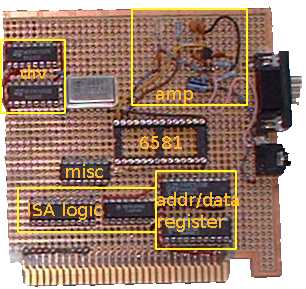SiDBlaster
an ISA SID based sound card

Of historical interest is the SiDBlaster which has now been
superseeded by the new Catweasel MK3/4
designs. This card was designed by Dirk Jagdmann and Michael Stickel in 2000. Only two
prototypes exist, of which the one shown in the photo was damaged by
water and is no longer functional. After Dirk and Michael build their
prototypes and got a basic linux driver working which verified the
cards operation with a simple SID ping, Dirk asked Tammo Hinrichs for help in developing a
real sid player. At the SCALA meeting in 1999 Dirk and Tammo coded in
6 hours a 6502 emulator which was
able to playback sid tunes. The first real music which was played by
this card was Schnoempf
from kb. And while copying the opcode table of the C64
reference manual Dirk and Tammo performed their famous
LDY,LDA,LDX,XXX Waltz.
Even if the cards are no longer functional and ISA slots are
rarely supported in modern computers the software which was initially
made for this card still lives on in the Catweasel drivers.
Hardware
The design is very straight forward and simply attached the SID to the ISA bus via two
8 bit registers for the data and address bus of the SID. We used two
74574
(8bit flipflop) for this purpose. To decode the ISA bus logic a 74138
(3to8 decoder) and 74688
(magnitude comparator) was used. We further used a 7402
for some additional bits needed. The operational clock for the SID is
a 1MHz oscilator, which is further divided by 20000 with two 40103
(down counter) to generate an ISA interrupt with 50Hz. For output we
copied the amplifier design used in the C64 with some resistors,
capacitors and a BC546.
In comparision with the roughly equal Hardsid
(ISA) we managed to offer the same features with considerably less
ICs and we had a stable 50Hz IRQ. We further had plans to extend this
basic design with audio and paddle inputs and a configurable IRQ of
50,60,100 and 120 Hz, but those were never realised.
Other hardware
Other projects to make the SID chip available on a PC system exist:
Also look at doublesid.de for information how to use multiple SID chips in a C64 computer.
|

